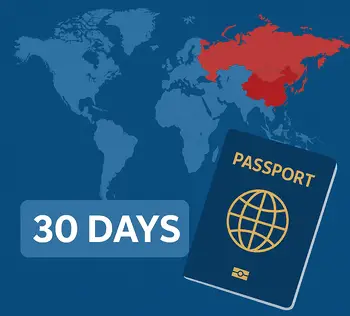
China’s emergence as a global economic powerhouse has prompted significant reforms to its traditionally restrictive immigration policies.
As the country transitions toward an innovation-driven economy, attracting and retaining international expertise has become a strategic priority.
This comprehensive analysis examines China’s evolving immigration landscape, highlighting recent policy developments, practical application processes, and the real-world challenges faced by foreign professionals.
China’s Talent Strategy: By the Numbers
China’s push to attract foreign talent must be understood within the context of its broader economic objectives and current demographics:
| Metric | Data | Source |
|---|---|---|
| Foreign workers in China (2023) | Approximately 400,000 | China National Immigration Administration |
| Annual work permits issued (2023) | 193,000 (down from 336,000 in 2019) | Ministry of Human Resources and Social Security |
| Permanent residency cards issued (2022) | 1,576 | National Immigration Administration Annual Report |
| Foreign students in China (2023) | 289,000 | Ministry of Education |
| Key talent shortage sectors | AI, semiconductor design, biotechnology, green energy | China Talent Development Report 2024 |
These figures reveal a significant gap between China’s ambitions and current reality.
While policy reforms signal openness, the actual number of foreign professionals remains relatively small compared to other major economies.
The Work Permit System: Categories and Requirements
In 2017, China introduced a three-tier, points-based work permit system that continues to form the foundation of its foreign employment framework:
Work Permit Categories
| Category | Target Group | Annual Quota | Processing Time | Validity |
|---|---|---|---|---|
| Class A (High-end talent) | Nobel Prize winners, top scientists, C-suite executives, professors | No quota | 5-10 working days | Up to 5 years |
| Class B (Professional talent) | Mid-level managers, technical specialists, experienced teachers | Subject to quotas | 10-15 working days | 1-2 years |
| Class C (Unskilled workers) | Service industry, manufacturing, seasonal workers | Strict quotas | 15-20 working days | ≤1 year |
Source: China Briefing
Points System Criteria
Applicants are evaluated based on a 100-point scale with the following key factors:
- Education level (max 20 points)
- Work experience (max 20 points)
- Annual salary level (max 20 points)
- Age (younger applicants receive more points)
- Mandarin proficiency (max 10 points)
- Employment location (additional points for developing regions)
A score of 85+ qualifies for Category A, 60-84 for Category B, and below 60 for Category C.
According to the Ministry of Human Resources and Social Security, approximately 23% of work permit applicants qualified for Category A status in 2023, with the majority (68%) falling into Category B.
Recent Policy Developments (2022-2024)
China’s immigration policies have undergone significant changes in recent years, particularly following the COVID-19 pandemic:
Post-Pandemic Reopening Measures
After nearly three years of strict border controls, China began reopening to foreign talent in early 2023. Key developments include:
- Resumption of visa services with streamlined procedures for high-skilled workers
- Introduction of the “Personal Affairs” visa category with longer validity
- Simplified documentation requirements for returning foreign residents
According to the Beijing Municipal Commerce Bureau, work permit applications increased by 62% in Q2 2023 compared to the previous quarter, signaling a gradual recovery.
Regional Innovation Zones
Several regions have implemented specialized immigration policies to attract talent to key innovation hubs:
| City/Region | Program Name | Key Benefits | Target Industries |
|---|---|---|---|
| Shanghai | “30 Measures for Foreign Talent” | Fast-track work permits, subsidized housing, school priority | Finance, AI, biomedicine |
| Greater Bay Area (Shenzhen, Guangzhou) | “GBA Talent Card” | Cross-border mobility, tax incentives, R&D funding | Tech hardware, advanced manufacturing |
| Beijing | “Phoenix Plan” | Research grants, simplified permanent residency | Quantum computing, aerospace, semiconductors |
| Hainan Free Trade Port | “Million Talents Program” | Tax exemptions, import privileges | Tourism, healthcare, modern services |
Source: Visas and Work Permits in China: A Quick Guide for Employers
The Reality of Chinese Permanent Residency
Despite reforms, China’s “green card” remains one of the world’s most difficult permanent residency permits to obtain:
Permanent Residency Statistics
| Year | Applications Received | Cards Issued | Approval Rate |
|---|---|---|---|
| 2019 | 7,356 | 1,336 | 18.2% |
| 2020 | 4,992 | 622 | 12.5% |
| 2021 | 5,108 | 834 | 16.3% |
| 2022 | 8,283 | 1,576 | 19.0% |
Source: National Immigration Administration Data
2023 Eligibility Criteria Updates
In April 2023, China updated its permanent residency eligibility criteria:
- Investment pathway: Minimum investment increased from $500,000 to $1 million with three consecutive years of operation
- Employment pathway: Requires at least four consecutive years of employment in China with a minimum annual income of 600,000 RMB ($85,000)
- Achievement pathway: Expanded to include recipients of China’s international science and technology cooperation awards
- Family reunification: Simplified process for spouses of Chinese citizens after five years of marriage
Dr. Wang Huiyao, President of the Center for China and Globalization, notes: “While the approval numbers remain low, the quality of applications has improved significantly, with a focus on strategic industries aligned with China’s development goals.”
Practical Application Process and Timeline
For professionals considering work opportunities in China, understanding the application process is essential:
Work Permit Application Process
- Employer pre-approval (2-3 weeks)
- Chinese employer obtains foreign worker employment license
- Notification Letter of Work Permit issued
- Visa application (1-2 weeks)
- Apply for Z visa at Chinese embassy/consulate in home country
- Submit Notification Letter and other required documents
- Work permit processing (7-15 working days)
- Medical examination at authorized hospital
- Work Permit application submission
- Biometric data collection
- Residence permit application (7-10 working days)
- Register with local police within 24 hours of arrival
- Apply for residence permit at local Public Security Bureau
- Submit work permit, lease agreement, and physical examination certificate
Total timeline: Approximately 6-10 weeks from initial application to final residence permit
Source: ECOVIS: Application Process Guide
Industry-Specific Opportunities and Restrictions
China’s talent recruitment efforts vary significantly by industry, with certain sectors receiving preferential treatment:
| Industry | Opportunity Level | Notable Programs | Restrictions |
|---|---|---|---|
| Technology | High | AI Innovation Action Plan, Integrated Circuit Talent Program | Data security clearances required |
| Education | Medium | Foreign Expert Certification, Double First-Class University Plan | Subject qualification requirements, age limits |
| Healthcare | Medium-High | Medical Valley Initiative, Biomedical Innovation Clusters | Medical license recognition challenges |
| Finance | Medium | Shanghai Financial Talent Program | Limited to specific roles, regulatory approval needed |
| Manufacturing | Low-Medium | Made in China 2025 Expert Recruitment | Limited to advanced manufacturing positions |
According to the American Chamber of Commerce in China, technology and healthcare remain the most accessible sectors for foreign professionals, while media, legal services, and government-related fields maintain significant restrictions.
Real-World Challenges and Solutions
Foreign professionals in China face several practical challenges beyond the application process:
Common Challenges
- Language barriers: Only 22% of work permit application materials are available in English
- Regional inconsistencies: Implementation of policies varies significantly between cities
- Banking limitations: Difficulties opening accounts and transferring funds internationally
- Internet restrictions: VPN requirements for accessing international websites and services
- Cultural integration: Limited support systems for adaptation to local work culture
Case Study: Navigating Regional Differences
James Chen, a software engineer from Canada working in Shenzhen’s tech sector, shares his experience: “The process in Shenzhen was remarkably different from what my colleagues in Beijing described. Local officials had significant discretion in interpreting requirements, and having a Chinese-speaking HR representative was essential for navigating the system.”
This experience aligns with findings from the European Union Chamber of Commerce in China, which reported that 68% of surveyed companies cited inconsistent policy implementation as a major challenge in talent recruitment.
Comparison with Competing Destinations
To contextualize China’s immigration reforms, it’s helpful to compare with other countries competing for global talent:
| Country | Work Visa Processing Time | Path to Permanent Residency | Foreign-Born Population % |
|---|---|---|---|
| China | 6-10 weeks | 4-8 years | 0.1% |
| Singapore | 3-5 weeks | 2-6 years | 29.4% |
| Canada | 4-19 weeks | 3-5 years | 21.5% |
| Germany | 4-12 weeks | 3-8 years | 16.1% |
| United States | 3-10 months | 3-10 years | 13.7% |
Sources: OECD Migration Database, UN Population Division
Future Outlook and Recommendations
Anticipated Policy Developments
According to immigration experts and government statements, several developments are likely in the coming years:
- Further digitalization of application processes
- Expanded talent programs targeting specific emerging industries
- Greater integration of immigration policies with China’s Belt and Road Initiative
- Potential reciprocal visa arrangements with key partner countries
Recommendations for Prospective Applicants
- Documentation preparation: Begin collecting and authenticating required documents 3-6 months before application
- Employer verification: Research potential employers’ experience with foreign worker sponsorship
- Regional selection: Consider second-tier cities with more favorable policies and lower competition
- Professional assistance: Engage immigration consultants familiar with local procedures
- Language preparation: Basic Mandarin proficiency significantly improves application success rates
Resources for Further Information
- National Immigration Administration – Official government immigration authority
- China Law Translate – English translations of relevant regulations
- China Briefing Immigration Guide – Regular policy updates and analysis
Conclusion
China’s immigration system continues to evolve as the country balances its need for international talent with broader social and economic considerations.
While significant reforms have been implemented to attract high-skilled professionals, practical challenges remain.
The system strongly favors those with specialized expertise in strategic industries, advanced degrees, and existing connections to Chinese institutions.
For qualified professionals, China offers unique career opportunities in rapidly developing sectors, particularly in technology and research.
However, prospective applicants should approach the process with realistic expectations, thorough preparation, and an understanding of both the formal requirements and informal practices that shape China’s immigration landscape.


